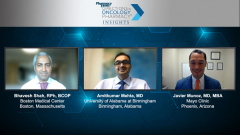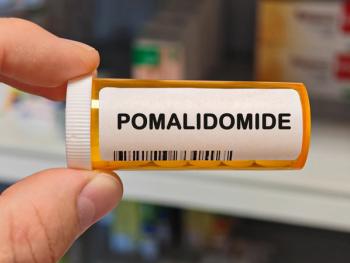
Management of Patients With Marginal Zone Lymphoma: Current Treatment Options
Shared insight on treating marginal zone lymphoma with the current treatment armamentarium.
Episodes in this series

Transcript:
Bhavesh Shah, RPh, BCOP: Moving along, we described the pathophysiology and prevalence. Let’s talk about treatment. How do you treat patients? Is it the same? You watch and wait, and I’m sure there’s maintenance therapy. Amit, do you want to take that question?
Amitkumar Mehta, MD: Yes, Bhavesh. As I was mentioning, marginal zone lymphoma is low-grade lymphoma, so we generally follow the same treatment guidelines for low-grade lymphomas. I discuss with my patients that low-grade lymphomas aren’t curable, especially if they’re advanced stage. Early stage, there’s still the potential for cure. We also follow the same guidelines for indication for treatment. Most of the time, these patients have accidental diagnosis of lymphoma. They were going for something, and they found a lymph node and a biopsy came back as marginal zone lymphoma. About 15% to 20% of patients with marginal zone lymphoma have symptoms. Once you diagnose, if they don’t have symptoms or don’t meet some of the criteria, as you mentioned, wait and watch is a very good approach. I don’t like the phrase wait and watch, so I call it active surveillance. Wait and watch means, “We’re going to wait for something to happen.” I’d rather say active surveillance. I’m going to actively look to see if something happens and then jump on the treatment.
For early stage, there’s still the potential for cure. You could achieve that by giving radiation. You’re always going to have a risk-benefit in that situation. It depends on the site you’re going radiate. If it’s axillary lymph node, you can radiate and have a patient cured with a low-grade lymphoma. For advanced stage, following the same guidelines, if they meet the indications for treatment, that’s when you jump in and do systemic therapy. CD20-directed therapies are the mainstay of frontline therapies if there’s low bulk and no B symptoms. But if they are advanced, have bulky disease, have total fusion, or have low blood counts—what we call cytopenias—that’s when you say, “You need chemoimmunotherapy.” In that setting, CD20-directed therapy, which is rituximab, is combined with either bendamustine or CHOP [cyclophosphamide, doxorubicin, vincristine, prednisone]– or CVP [cyclophosphamide, vincristine, prednisone]–based regimen.
Bhavesh Shah, RPh, BCOP: Thank you for that insight in terms of treating it. Understanding how powerful B-cell depletion therapies are in this disease, I recently read an article that said some of the patients with low-grade disease 7 years out can still be under remission just from having 4 doses of rituximab, which is amazing. The other question I had was in terms of maintenance therapy. What’s the strategy of maintenance for this patient population, especially if they’re getting single-agent rituximab, and then if it’s combination for the other patient population?
Amitkumar Mehta, MD: Great point, Bhavesh. Highlighting the importance of type is also important. Whether this is nodal vs a mucosa-associated marginal zone lymphoma or splenic marginal zone lymphoma, all would have different goals of therapy. Among this, I feel that advanced-stage nodal marginal lymphoma is the 1 that’s going to give you trouble. The others have relatively better outcomes.
You brought up a very good point about maintenance. We know that maintenance therapy improves progression-free survival for low-grade lymphomas, but we haven’t seen the impact on overall survival. That also applies to marginal zone lymphoma.
I want to highlight in the current time, especially in a pandemic, that when you put these patients on maintenance therapy, there are 2 disadvantages. The first is that they have to come more frequently to the clinic to get the infusion. That’s why they’re at relatively high risk of catching COVID-19. Hospitals are the main source. The second, which is important, is chronic B-cell depletion. That leads to hypogammaglobulinemia, which puts them at high risk of infections in general. Pneumonia and sinus infections are most common, and they also have a high risk of catching COVID-19 in that situation. Multiple recent short-term studies have shown that patients who are on maintenance or even vaccinated patients with lymphoma don’t import as much strong immune response from the vaccine compared with other patients.
Bhavesh Shah, RPh, BCOP: It’s important to highlight for our audience that we had identified that there was a very high mortality rate for patients who are on B-cell depletion therapy who developed COVID-19. We also eventually identified that if the vaccine isn’t timed appropriately, in terms of initiation of B-cell–depletion therapy, then you don’t mount adequate antibodies to fight, so patients would end up with COVID-19. They think they’re fully vaccinated and protected, but because it wasn’t properly timed, we saw failure of the vaccination. We were very proactive in identifying patients on B-cell depletion therapy for not just lymphoma but also rheumatoid arthritis and even MS [multiple sclerosis]. It’s really important to highlight that.
Thank you for sharing the COVID-19 perspective. Because on top of COVID-19, if you have limitations in how many chairs you have and how many patients you can treat in a day because of social distancing and timing of the fusions, it’s beneficial if you’re able to not do maintenance sometimes, because then you’re reducing that footprint for the patient and maybe even helping to improve efficiency in your clinic.
Amitkumar Mehta, MD: That’s true, especially when you don’t have survival benefit. The other thing I want to mention, which I emphasize for my patients, is to make sure they’re vaccinated. Especially if I have the luxury of planning the treatment, if they’re not vaccinated, I emphasize that. Even though the immune response is not great in patients with lymphoma, especially when they’re on therapy, they still get some immune response, and that may help in terms of COVID-19 infections.
Transcript edited for clarity.
Newsletter
Stay informed on drug updates, treatment guidelines, and pharmacy practice trends—subscribe to Pharmacy Times for weekly clinical insights.













































































































































































































